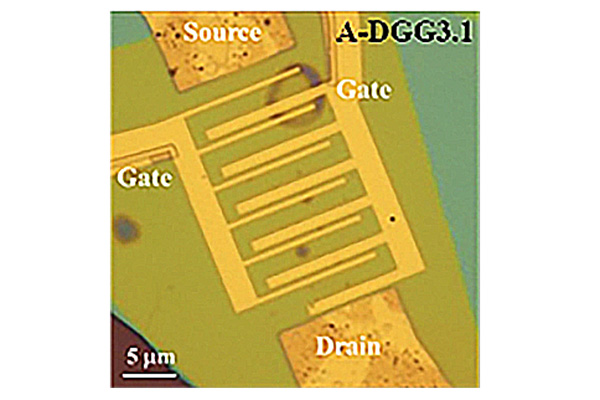Sep 8 2020
A team of international researchers has been successful in achieving coherent amplification of terahertz (THz) radiation in graphene at room temperature.
 A scanning-electron microscopic top-view image of a fabricated graphene transistor structure under measurement. It features the unique transistor electrode structure called “double-grating gate,” where two sets of gate electrodes that have a comb-like grating shape are prepared and arranged in an interdigitated fashion. Image Credit: © Tohoku University.
A scanning-electron microscopic top-view image of a fabricated graphene transistor structure under measurement. It features the unique transistor electrode structure called “double-grating gate,” where two sets of gate electrodes that have a comb-like grating shape are prepared and arranged in an interdigitated fashion. Image Credit: © Tohoku University.
Led by Taiichi Otsuji, a professor from Tohoku University, the researchers achieved this by using a dry cell battery to electrically induce the radiation.
About 40 years ago, the advent of plasma wave electronics paved the way for a wide range of new opportunities.
Researchers across the world were enthralled with the likelihood that plasma waves could travel faster compared to electrons, implying that the so-called “plasmonic” devices could operate at THz frequencies. But experimental efforts to achieve the development of such emitters or amplifiers have been intangible to date.
Our study explored THz light-plasmon coupling, light absorption, and amplification using a graphene-based system because of its excellent room-temperature electrical and optical properties.
Taiichi Otsuji, Professor, Ultra-Broadband Signal Processing Laboratory, Research Institute of Electrical Communication (RIEC), Tohoku University
The team of researchers, including members from Japanese, Russian, French, and Polish institutions, developed a range of monolayer-graphene channel transistor structures. These structures included an original dual-gathering gate that served as a highly efficient antenna that couples the THz radiations with the graphene plasmons.
The use of these devices enabled the research team to demonstrate the absorption of tunable resonant plasmons that, with an increase in current, leads to amplification of the THz radiation.
The gain in amplification of up to 9% was obtained in the monolayer graphene—much more than the well-known benchmark level of 2.3%, which is the maximum available amplification when photons tend to interact directly with electrons without the excitation of graphene plasmons.
The researchers interpreted the study results by using a dissipative plasmonic crystal model, thus capturing the basic physics and main trends of the amplification phenomena. In particular, the model estimates the increase in the dc current of the channel, which pushes the system into an amplification regime.
This shows that the plasma waves might transfer the dc energy into the incoming THz electromagnetic waves in a coherent manner.
Because all results were obtained at room temperature, our experimental results pave the way toward further THz plasmonic technology with a new generation of all-electronic, resonant, and voltage-controlled THz amplifiers.
Taiichi Otsuji, Professor, Ultra-Broadband Signal Processing Laboratory, Research Institute of Electrical Communication (RIEC), Tohoku University
Journal Reference:
Boubanga-Tombet, S., et al. (2020) Room-Temperature Amplification of Terahertz Radiation by Grating-Gate Graphene Structures. Physical Review X. doi.org/10.1103/PhysRevX.10.031004.